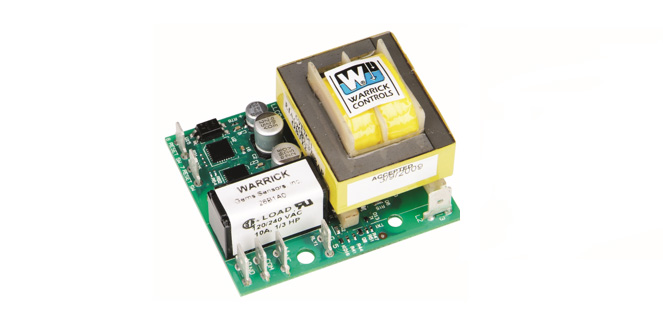Warrick Relay Under Sensing Technical Help

One common issue that can happen with conductivity relays is under sensing the liquid. The below points discuss what may be causing the relay to under sense and remedies to address it.
Under-Sensing: When the relay is not sensing liquid even when liquid is present.
- Incorrect Sensitivity selected on controller:
- As mentioned above, the controller’s sensitivity must be greater than or equal to the liquid’s sensitivity. If your controller has a value less than the liquids, it won’t be able to sense the liquid’s presence. For example, Condensate Water has a sensitivity of 18K Ohms/cm. If you are using a relay with the 10K Ohms/cm then it won’t be able to properly conduct through that liquid. You would need to select the 26K Ohms/cm option. For boilers, since the media may be a mixture of condensate and natural water, selecting the 26K Ohms/cm is recommended.
- As mentioned above, the controller’s sensitivity must be greater than or equal to the liquid’s sensitivity. If your controller has a value less than the liquids, it won’t be able to sense the liquid’s presence. For example, Condensate Water has a sensitivity of 18K Ohms/cm. If you are using a relay with the 10K Ohms/cm then it won’t be able to properly conduct through that liquid. You would need to select the 26K Ohms/cm option. For boilers, since the media may be a mixture of condensate and natural water, selecting the 26K Ohms/cm is recommended.
- Dirty Probes or Tank Walls:
- If the probes become dirty or coated, then it makes it harder for the relay to conduct through it properly. Also, if you are using the tank wall as your ground probe, then the same issue arrives. If the inner tank wall becomes coated with minerals and debris, it will impede the conductivity. Cleaning the entire tank is a lot more troublesome then cleaning a probe, so it’s recommended to use a probe for the ground instead of the tank when possible.
- If the probes become dirty or coated, then it makes it harder for the relay to conduct through it properly. Also, if you are using the tank wall as your ground probe, then the same issue arrives. If the inner tank wall becomes coated with minerals and debris, it will impede the conductivity. Cleaning the entire tank is a lot more troublesome then cleaning a probe, so it’s recommended to use a probe for the ground instead of the tank when possible.
- Sharing ground probes/tank:
- You can share a conductivity ground between multiple relays, but it may lower the relay’s sensitivity. So, if you are under-sensing, you may want to add an additional ground probe per relay.
- You can share a conductivity ground between multiple relays, but it may lower the relay’s sensitivity. So, if you are under-sensing, you may want to add an additional ground probe per relay.
- Improperly treating the water:
- Treating the boiler water to adjust hardness and/or adding corrosion inhibitors may affect the water’s conductivity. You may need to measure the water’s conductivity routinely with a conductivity meter to ensure correct sensitivity levels.
- Treating the boiler water to adjust hardness and/or adding corrosion inhibitors may affect the water’s conductivity. You may need to measure the water’s conductivity routinely with a conductivity meter to ensure correct sensitivity levels.
- Using a panel or electrical ground:
- The reference or ground terminal on the relay should only be connected to the reference probe (or tank) and should not be connected to a panel or electrical ground. Connecting it to a panel ground may introduce voltage noise and confuse the relay.
- Trying to use conductivity sensors in ultra-pure or non-conductive liquids:
- Ultra-pure waters like Reverse Osmosis (RO) or Deionized (DI) water are so pure that almost all the minerals that help conduct voltage have been removed. Therefore, you need such a high sensitivity relay to have a consistent reading. Also, any hydrocarbons are not conductive by nature, so even the highest sensitivity will not work. For ultra-pure water, and hydrocarbons, it’s recommended to use a float-based switch like our LS-800, LS-700, which can still be connected to the Warrick relays to control the logic. Just make sure all the floats are Normally Open logic.
Additional Items to Consider:
- Make sure high voltage wires are not near the relay or probes as it can introduce voltage noise.
- Do not place high voltage wires (120/240 VAC) within the same conduit as the probe wires as it can introduce voltage noise.
- Old style Warrick Relays (like Series 1, 2) cannot be within the same tank as current style relays (Series 16, 26). The old-style relays sent a higher voltage out on the probes and will thus confuse the current style relays.
- Make sure the relay is protected from voltage spikes with a surge protector, as this can damage the relay.
- When using the relay as a single level service for low level alarm, you still connect to the High (H) and G (Reference) terminals on the relay. The relay will look to the (H) probe first so it must always have a probe connected to it.
- Make sure MTW or THHN #14 or #16 AWG wire is used between probes and relay.
- Make sure distance between probes and relay does not exceed distance noted on the Sensitivity Data chart on page E-2. The higher the sensitivity the less distance the wires can be. However, select the sensitivity based on the liquid first. If the distance is too far, consider switching to a lower sensitivity to achieve the longer length, but still maintain a controller sensitivity greater than the liquid.
Please refer to the Instruction Bulletin for wiring diagrams and additional installation instructions.
 SEARCH OUR RESOURCE CENTER
SEARCH OUR RESOURCE CENTER
